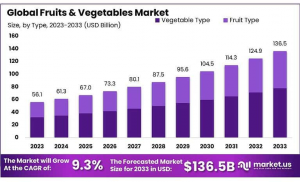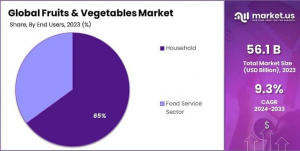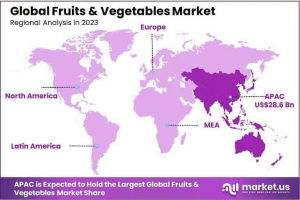Rum market is valued at USD 15.2 Billion in 2022, This market is estimated to reach USD 25.0 Billion in 2032 It is expected to grow at a CAGR of 5.1%
APAC is the dominant region in the global Rum market, with a market share of 42.5% of global revenue.
”
NEW YORK, NY, UNITED STATES, February 4, 2025 /EINPresswire.com/ -- Overview— Tajammul Pangarkar
The global rum market, valued at USD 15.2 billion in 2022, is projected to reach USD 25.0 billion by 2032, with a compound annual growth rate (CAGR) of 5.1% from 2023 to 2032. Rum, originating from sugarcane by-products, has become a staple in the alcoholic beverages market, known for its versatility in cocktails and its historical ties to the Caribbean. The market's growth is buoyed by rising consumer interest in diverse and premium rum products, aligning with global cocktail trends and a burgeoning mixology culture. Key producers, primarily in Caribbean nations like Jamaica, Puerto Rico, and the Dominican Republic, are leveraging this trend as they supply the world market with varied rum offerings.
The light/gold rum segment dominates due to its popular use in cocktails, while off-trade channels, particularly during the recent global pandemic, have seen significant growth as consumers shifted to home consumption. Asia Pacific is the leading region, driven by changing consumer preferences and an increasing demand for premium and craft rums. The market dynamics are shaped by both opportunities in flavor innovation and challenges such as taxation and stringent regulations affecting production and distribution.
Key Takeaways
• The global Rum market is valued at USD 15.2 Billion in 2022.
• By Product Type, the light/gold Rum segment dominates the market with a market share of 6% in 2022.
• By nature, the plain rum segment dominates the market with more than 60% market share in 2022.
• The distribution Channel off-trade segment led the market in 2022 with a market share of 76.5%.
• In 2022, the APAC region will be the dominant region in the global Rum market, with a market share of 42.5% of global revenue.
• With sales of around 21.1 million 9-liter cases in the year 2022, Bacardi was the second-largest rum brand in the world.
• Alcohol intake across Europe is highest at around 15 liters per person annually.
👉 Request a free sample PDF report for valuable insights: https://market.us/report/rum-market/request-sample/
Experts Review: Government Incentives and Technological Innovations
Government incentives and technological innovations are reshaping the rum industry landscape. Subsidies and support for sugarcane production in key producing countries provide a stable supply base, while advancements in distillation and aging technologies enhance rum quality, catering to the evolving palate of premium spirits enthusiasts. Investment opportunities are becoming more attractive as the market expands, yet they carry risks related to fluctuating raw material prices and regulatory changes impacting production processes. Consumer awareness is increasingly aligned with sustainability and authenticity, pressing manufacturers to adopt transparent practices and environmentally-friendly production measures.
The technological impact is evident in improved efficiency and product consistency, encouraging producers to experiment with new flavors and aging techniques. Regulatory environments, however, remain complex, with different regions imposing varied degrees of control over production, export, and marketing, posing compliance challenges. The rum market's competitive landscape is robust, requiring ongoing adaptation and strategic positioning among stakeholders to leverage growth while navigating potential risks in this dynamic global sector.
Report Segmentation
The rum market is segmented by product type, nature, distribution channel, and geography. In terms of product type, it includes light/gold rum, white rum, dark rum, and spiced rum. Light/gold rum, popular for cocktail preparation, leads the segment due to its premium appeal and versatility. The nature segment includes plain and flavored rum, with plain rum commanding a significant market share by offering a timeless classic appeal. Distribution channels are categorized as on-trade, off-trade, and online retail. Off-trade channels such as supermarkets dominate the market, supported by a trend towards home consumption.
From a geographical perspective, the report covers key regions including North America, Europe, Asia Pacific, Latin America, and the Middle East & Africa. Each region's market dynamics differ based on cultural consumption practices, economic factors, and regulatory standards, offering a comprehensive view of the global market landscape. The segmentation provides insights into the diverse consumer preferences and market opportunities across the regions, enabling stakeholders to formulate targeted strategies for market penetration and expansion.
Key Market Segments
Based on Product Type
• Light/Gold Rum
• White Rum
• Dark Rum
• Spiced Rum
Based on Nature
• Plain
• Flavored
Distribution Channel
• On-Trade
• Off-Trade
• Online Retail
👉 Buy Now to access the full report: https://market.us/purchase-report/?report_id=106518
Drivers, Restraints, Challenges, and Opportunities
The rum market's growth is driven by rising consumer preference for premium and craft rums, fueled by their diverse flavors and suitability for cocktail culture. Craft distilleries are gaining traction by emphasizing traditional production methods and premium ingredients, attracting consumers seeking unique drinking experiences. However, restraints include stringent regulations and trade restrictions that complicate global distribution and marketing. High taxes and regulatory compliance costs pose additional challenges, potentially limiting profitability.
The industry also faces competition from other alcoholic beverages that vie for consumer attention. Despite these challenges, significant opportunities lie in flavor innovation and premiumization, enabling producers to cater to a burgeoning demand for sophisticated and exotic tastes. Craftsmanship and authenticity are increasingly valued, allowing artisanal producers to differentiate themselves. There is also a notable opportunity in expanding to emerging markets with growing middle-class populations, such as India and China, where consumer interest in premium spirits is on the rise. Capitalizing on these trends requires strategic marketing and adaptive business practices to navigate the complex regulatory and competitive landscape.
Key Player Analysis
Major players in the global rum market include Bacardi Limited, Diageo Plc, Pernod Ricard SA, and Davide Campari-Milano N.V., among others. Bacardi, a historically dominant brand, maintains a substantial market presence through its extensive product line and strong brand recognition. Diageo, with its broad portfolio and global reach, leverages strategic acquisitions to enhance its market position. Pernod Ricard and Davide Campari-Milano focus on premium and innovative products to capture niche segments.
These companies invest heavily in marketing and brand building to maintain and grow their market share. The competitive landscape is characterized by a mix of large multinational corporations and smaller, emerging craft producers, each employing unique strategies to attract a diverse consumer base ranging from traditional rum enthusiasts to modern mixology aficionados. The focus on quality, branding, and consumer engagement remains pivotal for sustaining growth and competitiveness in the evolving market.
Market Key Players
• Bacardi Limited
• Davide Campari-Milano N.V.
• Demerara Distillers Ltd.
• Diageo Plc
• LT Group, Inc.
• Nova Scotia Spirit Co.
• Pernod Ricard SA
• Suntory Holdings Ltd
• William Grant & Sons Ltd
• Tanduay Distillers
• United Spirits
• Demerara Distillers
• Stock Spirits
• Amrut Distilleries
• Brown–Forman
• Other Key Players
Recent Developments
Recent developments in the rum market highlight strategic moves by key players to capture emerging opportunities and address market challenges. In March 2023, Bacardi introduced Bacardi Caribbean Spiced, a premium spiced aged rum featuring flavors like pineapple and cinnamon, catering to the growing demand for flavored rums. Brown-Forman's acquisition of Diplomático Rum in January 2023 underscores its expansion into the super-premium rum category, aiming to leverage consumer preference for high-end spirits.
Similarly, Diageo's acquisition of Don Papa Rum in the same month for €260 million signifies its commitment to expanding its premium dark rum offerings, thus enhancing its portfolio to tap into diversified consumer tastes. These strategic acquisitions and product innovations indicate a robust trend towards premiumization and flavor diversification in the rum market. These actions are expected to drive growth by appealing to new segments and reinforcing brand presence in competitive markets.
Conclusion
The global rum market is poised for robust growth, fueled by consumer trends favoring premium, diverse, and craft spirits. While challenges such as regulatory complexities and competitive pressures persist, opportunities abound in flavor innovation and expanding into emerging markets. Leading brands are strategically enhancing their portfolios through acquisitions and new product launches to meet evolving consumer preferences. As the market continues to expand, producers must navigate regulatory environments and market competition while embracing technological advancements and sustainability practices. Ultimately, the rum market remains dynamic, adaptive, and ripe with potential for stakeholders who can effectively leverage its opportunities and mitigate associated risks.
Lawrence John
Prudour
+91 91308 55334
Lawrence@prudour.com
Visit us on social media:
Facebook
LinkedIn
Legal Disclaimer:
EIN Presswire provides this news content "as is" without warranty of any kind. We do not accept any responsibility or liability for the accuracy, content, images, videos, licenses, completeness, legality, or reliability of the information contained in this article. If you have any complaints or copyright issues related to this article, kindly contact the author above.




